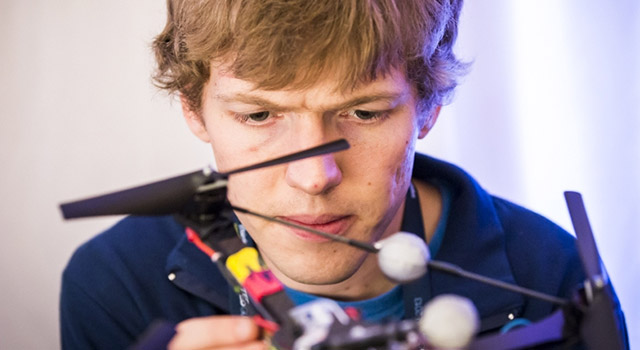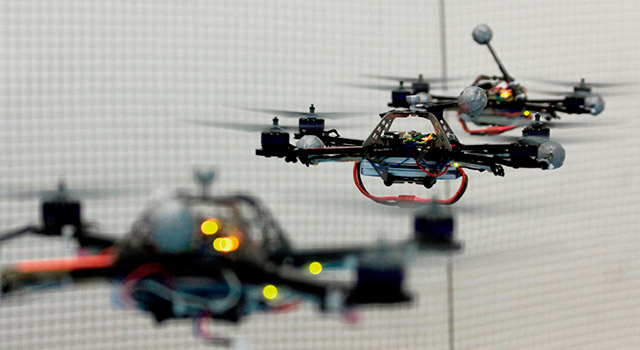
Quadrocopters in South Africa have made headlines in recent months over whether it’s legal to use them. But quadrocopters are not just tools for filmmakers or toys for fun — there is a more serious side to them, one that could change the way we look at robotics.
A South African robotics student living in Switzerland is working with some of the brightest minds in the world to produce research on collaborating robots in autonomous flight. Mark Müller, 28, is studying for his PhD under world-renowned roboticist Prof Raffaello D’Andrea at the Swiss Federal Institute of Technology in Zürich (ETH).
Müller can be found at the university’s Institute of Dynamic Systems and Control. “It’s somewhat removed from the commercial debates currently underway in the industry,” he tells TechCentral via a Skype interview. “Two noticeable points of difference are that we don’t have a human pilot in the loop, and our flying robots collaborate to perform complex tasks, like building towers, catching balls and juggling, in a closed system that also enables learning.”
Müller matriculated from Hoërskool Hartbeespoort, north-west of Johannesburg, in 2004. He graduated with a B Eng degree in mechanical engineering from the University of Pretoria in 2008 and then received a scholarship to do his MSc, also in mechanical engineering, at ETH. This is where he met D’Andrea. Their research seeks to redefine what autonomous systems are capable of.
Robotics was not always an option for Müller. “I always knew about robotics, but it seemed like something so inaccessible. I soon realised this was not the case. I think that for a kid in South Africa, it’s not unrealistic anymore to build a robot and tinker with technology. This is partly because the tools are a lot more readily available online.”
Müller expects to complete his PhD in mid-2015, after which he intends embarking on an academic career. “I think my career will always focus on robotics,” he says. “The world in 20 or 30 years will be vastly different to what we know now.”
Robotics will open up many possibilities that will benefit everyone, he says.
Arena of flying robots
The best way to understand what Müller and his fellow students are working on is to watch the impressive autonomous flight project called Flying Machine Arena (FMA) — see the video below. Essentially, the FMA is a portable space devoted to autonomous flight and consists of a high-precision motion capture system, a wireless communication network and custom software that executes sophisticated algorithms for estimation and control.
The arena was built so that it can capture motion and locate multiple objects in the space, at rates exceeding 200 frames per second. This precision positioning system, which functions much like GPS, allows the team to develop complicated algorithms that are fused with data from the quadrocopters to predict the state of the objects into the future, allowing them to develop the correct responses.
The system uses this knowledge to determine what commands the vehicles should execute next to achieve their desired behavior, such as performing high-speed flips, balancing objects, building structures, or even engaging in a game of paddle-ball.
The system is then able to send system commands via wireless links to the quadrocopters, which execute them with the help of onboard computers and sensors such as rate gyros and accelerometers. Although the FMA will work with various objects, the team uses quadrocopters due to their agility, robustness and mechanical simplicity, says Müller.
The quadrocopters are able to accelerate at 15m/s² and flip at 2 000 degrees per second, hovering at one moment while juggling and balancing objects the next. The radio commands that instruct the machines are transmitted at 50 times per second and each machine is about 50cm from tip-to-tip and weighs 500g. Further to the overhead cameras, the quadrocopters are fitted with accelerometers and angular rate gyroscopes to measure motion.
“We are four PhD students working with Prof D’Andrea and we all work on different aspects of the project,” explains Müller. “I work on trajectory generation. This is how you move the vehicle from one point in space to another. I also work a bit on fail-safe technologies and how to react to unexpected events and recover from failures.”

Müller’s colleagues work on other aspects of the project, including the learning abilities of these autonomous robots and how the quadrocopters build structures. One of the students is working on building novel new vehicles to work in the FMA. “We all do a little bit of development infrastructure, so working on getting the measurements and radio communications right … we do quite a lot of mathematics.”
All of their ideas start with a sketch on a piece of paper. This is done to determine if the maths makes sense, says Müller. If it does, the team starts to code the simulation, a simple test to see if they got the maths right and that the solution makes sense.
“We then do a more complicated simulation and finally we will implement it on a real system to see if it works. We spend a lot of time programming because in some sense; this is where the rubber meets the road.”
Robotic helpers
One of the team’s research areas is what Müller calls the next big thing in robotics: service robotics. “We are surrounded by dull and tedious jobs that are too complicated to automate at this point,” he says, using the example of an automatic vacuum cleaner. “If you can get robots to clean your house, you will have more time to do other things. It’s is a trivial example, but it extends to many things. This is the true ‘next big thing’: reducing the load on people and moving the tedious work to robots.”
Roboticists have been working on this problem for a long time, but Müller says much work still has to be done. There are still many challenges that have to be overcome before autonomous robots regularly assist us in our everyday lives.
“The technical challenges are quite large and include things like perception,” he explains. “We live in a world that is made for people and not necessarily for robots.”
How a robot perceives the real world, and how it interacts with it, is part of that challenge. “For a human, it is trivial to pick up a cup and put it somewhere else. Automating the same task with robotics is difficult.”

Another big problem is public acceptance and regulation around the use of robots. “But these are societal challenges, not technical ones we have to overcome.”
Müller and other members of the team will attend the 19th World Congress of the International Federation of Automatic Control in Cape Town in late August. This event which, is held every three years, promotes automatic control (which include robotics) to the public. — © 2014 NewsCentral Media

